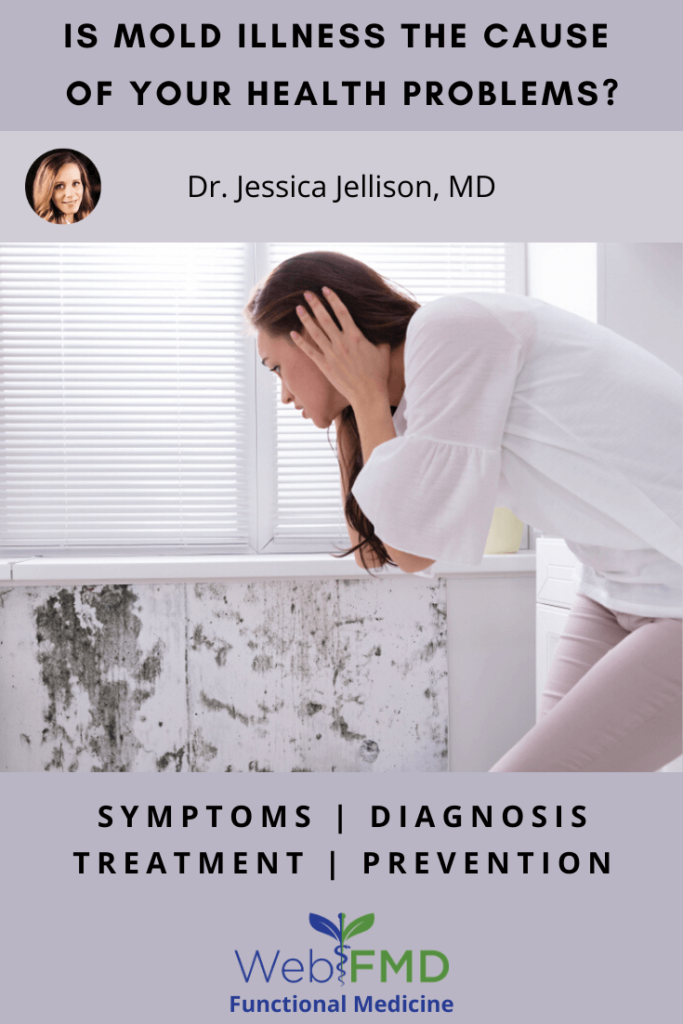 |
Dr. Jessica Jellison, M.D. Functional Medicine Doctor Mold Illness Expert |
Symptoms | Diagnosis | Timeline | Treatment | Prevention
With a growing body of evidence that links many health problems to mold exposure, mold illness is more common than many people realize. In this interview, we spoke with Dr. Jessica Jellison, M.D., a functional medicine doctor who specializes in mold illness and chronic inflammatory response syndrome (CIRS).
After recovering from mold illness herself, Dr. Jellison knows both the patient and clinician’s point of view, including the many challenges in the diagnosis and treatment. Learn about the common symptoms of mold illness, testing for mold toxicity, how to know if you have mold in your house, and the treatment approach.
A Q&A with Dr. Jessica Jellison
How did you first get interested in mold illness?
In medical school, I started to experience anxiety attacks, chronic fatigue and “brain fog”, which were out of the norm for me. All the testing came back normal. It was suggested that my symptoms were related to the stress of being a medical student.
For me, it didn’t make sense that there was nothing really wrong with me. I had never had these symptoms before despite experiencing and handling stress without issue. I knew there had to be another explanation, so I kept digging. It was when I came across the integrative and functional medicine approach to mold illness, with the help of my husband, Dr. Paul Reicherter, that I realized that my symptoms were caused by mold toxicity.
After studying the role mycotoxins (mold toxins) play in chronic illness and knowing firsthand how mold illness feels with all these challenges, I just couldn’t turn back. Ever since then, mold illness and chronic inflammatory response syndrome (CIRS) have been a major part of my clinical practice.
What are the common symptoms of mold illness?
Typically, people tend to think of mold symptoms more like an allergic response to mold, with symptoms such as sneezing, coughing, tearing of the eyes, and headaches.
But those are not the only symptoms of mold illness. I think that’s really what confuses people. Mold illness can affect the entire body. I often see patients that have been on a health journey for a long time dealing with symptoms that do not add up or make sense.
Mold illness can cause any of these symptoms:
- Chronic fatigue
- Weakness
- Diminished cognitive function, memory loss, “brain fog”, difficulty concentrating, confusion
- Mood swings, anxiety, depression, irritability, anger
- Stomach pain, especially in kids
- GI fluctuations with constipation and diarrhea, especially in kids
- Excessive thirst
- Increased urination
- Joint pain
- Lightheadedness
- Metallic taste in mouth
- Weight gain (usually due to increased inflammation), but also in some cases, weight loss or inability to put on weight
- Neuropathy issues such as numbness and tingling in lower extremities, hands or other areas in the body
Mold exposure can also lead to Chronic inflammatory response syndrome (CIRS), especially in people who are genetically susceptible (around 25% of the US population). So, with CIRS, there may be additional symptoms:
- Shortness of breath
- Heightened skin sensitivity
- Disorientation
- Sensitivity to light
- Trouble learning new info
- Blurry vision
- Night sweats
- Red or bloodshot eyes
- Static shocks
- Morning stiffness
- Muscle cramps
- Vertigo (the feeling of the room spinning)
- Appetite swings
- Trouble regulating body temperature (feeling cold or hot when the outside temperature is perfect)
How do you diagnose mold illness?
I often start with a few basic tests if I suspect someone has mold illness, although the exact plan may vary from one patient to another.
The objective is not to run every possible test, but to focus on the essential tests that can change the course of the treatment. So we personalize the plan for each patient according to their individual symptoms, medical history, finances, personal preferences, and other factors.
For example, I see many patients who already know they have black mold or see visible mold in their homes. They’re not feeling well with some of the mold illness symptoms present. In such cases, since we already know there’s an ongoing current exposure to mold, we may not need to test their urine for mycotoxins.
Some of the basic tests for mold illness include:
Mycotoxins urine test
This test (by Great Plains Laboratory) screens for 11 different mycotoxins from 40 species of mold in the urine.
Taking Glutathione daily for seven days before the urine testing can help eliminate more mycotoxins through the urine.
Glutathione is a major antioxidant in our body that plays a key role in detoxification. This gives us a better clinical picture of the type of toxins someone is dealing with and often helps guide the treatment for each patient.
Home testing for mold
A home test for mold called ERMI (Environmental Relative Moldiness Index) screens for 36 mold species in dust samples you collect at home. Think about it as a way to test the health of your home in terms of mold.
If the type of molds found on the test overlaps with the ones found on the urine test, then we know you probably have a current mold exposure in your house. If there’s no correlation, there may be other sources of exposure (for example, your office), or there could be a problem with mold exposure in the past.
While the ERMI can be very helpful, it doesn’t tell you the location in the house where there’s a mold problem. For best results, I usually advise my patients to run multiple ERMI tests: one for the basement (many mold problems originate in the basement), another test for the main floor, and another if you have a top floor.
Biomarker testing
Mold toxicity can cause certain abnormalities that may need to be addressed during the treatment. Some of the common biomarkers tested include Transforming Growth Factor Beta 1 (TGF-beta-1), Matrix metalloproteinase-9 (MMP-9), and Melanocyte Stimulating Hormone (MSH).
Depending on the symptoms and medical history of each patient, I may run specific tests for SIBO, food sensitivities, nutritional deficiencies, liver and kidney function, and others.
How long does it take to get sick from mold exposure?
I have some patients that visit a house with a mold problem and start having symptoms within seconds of entering. This is common in people that have already had a prior mold exposure, or mold illness. Their body is very quick to respond with symptoms.
Other people that haven’t had a prior exposure could be in the same house for a few hours without noticing any symptoms. They may feel tired the next day, or start to develop a cough, a runny nose or get headaches, or they may be just fine.
Some people can be in a moldy environment every day and not even realize it. I see patients who have been going to work every day staying in a moldy office for years, before they noticed symptoms.
So, depending on a person’s immune system, genetic susceptibility to mold, prior exposure, the types of molds that are present in the environment and their capacity, there are a lot of factors that play a role in the symptoms, and their severity.
How do you treat mold sickness?
Treating mold illness should always be personalized since mold toxicity can affect people differently. Some of the basic steps I usually start with include:
1. Stop the mold exposure
First and foremost, in order to start healing from mold illness, it is absolutely critical to make sure the environment is safe. Keep in mind, mold inspection and mold remediation require a level of expertise that goes beyond standard repair. So it is important to work with professionals specialized in mold.
If mold is found in the inspection, it is best not to be present in the house during mold remediation, especially if you know your home has Stachybotrys or Chaetomium. If not done properly, disturbing the mold can release more mycotoxins into the air which can worsen your symptoms.
On that note, walking away from your home during remediation is never an easy thing to do. If it’s not possible, cleaning a “safe” room may help with some symptom relief, although it is not a permanent solution. Mycotoxins can easily travel through the air, and you are still going to have some exposure to other areas in the house (kitchen, bathroom) that may have a mold problem. Work with your provider and together explore the next best steps.
2. Nutritional support
I find that many of my patients who have mold illness are nutritionally depleted. Once we have their levels restored, they often feel better.
Keep in mind, some nutrients such as B vitamins enhance the body’s ability to detox, so it is important to go low and slow.
The nutritional support each person may need can be very specific, although some of the supplements I often use for mold illness include:
- Glutathione. Supports the body’s detoxification pathways and helps eliminate more mycotoxins from the body.
Some people are dealing with such high toxicity levels that they may feel sick from detoxifying large amounts of mycotoxins after they take glutathione. To minimize these issues, it is important to personalize the serving size to each patient. - Supports cell membrane repair.
- Fish oil: Helps reduce inflammation and lower high levels of Matrix metalloproteinase-9 (MMP-9).
- Coenzyme Q10 (CoQ10). Key antioxidant that can protect the mitochondria from free radical damage and help with energy production.
3. Mycotoxins binders
Certain substances have the ability to bind to toxins such as mycotoxins, so they can be eliminated through bowel movements. For mold illness treatment, I may use natural binders such as activated charcoal, bentonite clay, or GI Detox (by BIO-BOTANICAL RESEARCH).
Some prescription medications such as Cholestyramine or Welchol also have mycotoxins binding abilities.
When taking binders:
- Take away from food, medications and supplements, as binders may prevent them from being absorbed.
- Drink plenty of water to avoid dehydration and constipation.
- Make sure you have at least one bowel movement every day. Binders will increase toxin elimination, so it’s crucial your bowels are functioning properly.
4. Additional Therapies & Considerations
- Lower chemical load. Reduce exposure to potential toxins found in common household, personal care, and beauty products, as well as foods.
Think Dirty® app, ewg.org are great resources to increase the awareness of these toxins. - Far Infrared Sauna therapy. Can help increase toxin excretion via sweat, urine, and stool. Some people can only tolerate three to five minutes, so start slow and see how you feel. To avoid dehydration, make sure to drink extra water and have electrolytes onboard prior to the sauna.
- Red light Therapy (Joovv). Help support the mitochondria, improve circulation and reduce inflammation.
Is there a special diet for mold illness?
Generally speaking, I find that adding a restrictive diet on top of all the other steps in the treatment can make people feel very overwhelmed.
I think a good place to start for most people is to eliminate sugars and focus on organic whole foods based healthy eating.
However, some people with gut issues, food sensitivities or other concerns may need a more specific diet.
How long does it take to heal from mold illness?
Most of the time when people are able to get out of the moldy environment and stop the mold exposure, they start feeling better within weeks to months. Keep in mind, mold illness can affect the entire system. It may take the body three to five years to completely heal from the damage caused by years of mold exposure.
The duration of the mold exposure, the types of mold, how fast the body eliminates mold, genetic susceptibility to mycotoxins, toxin load, and other factors all play a role in the time it takes to heal from mold illness.
Don’t give mold a chance to grow! My tips to prevent mold:
- Keep indoor humidity between 40-60 percent.
- Use top-load washers. Front loaders are more prone to mold since they collect water which allows mold to grow.
Let the washer dry out completely before you close the lid. - Use an oscillating fan after you shower. Helps to dry all wet areas when you’re out of the shower.
- New houses can have mold issues too. People are often surprised to learn that mold issues in new homes is also common. Modern building guidelines do not usually look at mold prevention as their main priority. If you have an opportunity to move to a new building, it is always best to work with reputable professionals who specialize in mold and have them inspect the home.
Final Thoughts
Mold illness can be an overwhelming condition. Not only does it affect the person, it can affect the entire family including their home.
I know this firsthand! Breathe and take a step back. Remind yourself that it’s going to be okay. We know enough about mold illness and have plenty of tools to help you get better.
An experienced physician who specializes in mold illness can help you navigate through the challenges you are facing. This physician can get an accurate diagnosis and help implement effective treatment, including the steps needed to inspect and remediate your home. I hope you find this total-wellness approach to mold illness helpful. I wish you the very best success in your journey to optimal health and wellbeing.
- Is Mold Illness the Cause of Your Health Problems? - June 26, 2020
- Finding the Cause of Chronic Fatigue Syndrome: Peeling Back the Layers of the Onion - March 27, 2020




